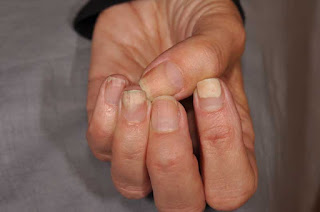HOMOEOPATHY FOR ONYCHOLYSIS
Onycholysis is the painless separation of the nail from the nail
bed. Onycholysis occurs when the nail separates from the nail bed or the skin
directly beneath the nail. There are several possible causes for this common
condition.
Onycholysis can last for several months and will typically
correct itself when the nail fully grows out. Until then, the nail will not
reattach to the skin beneath it.
Recovery time varies for onycholysis as it is
largely dependent on nail growth. It is not uncommon for fingernails to take
about 4 to 6 months to grow to a full size. Toenails may take up to 8 months.
Onycholysis can affect multiple units or a
single nail unit. If multiple nail units are affected , a systemic cause is a
more likely culprit. If a single nail unit is affected , a history of trauma
can often be elicited in the clinical history.
Causes
The cause of a person's onycholysis varies widely. A person may
experience an injury or repetitive trauma.
·
Simply tapping nails repeatedly for a long time can cause the
nail to separate from the skin.
·
Injuries such as slamming a finger in a car door or stubbing a
toe may also cause onycholysis.
·
Reaction to chemicals, such as nail polish, nail polish remover,
or household cleaners
·
Fungal infections, common in the feet
·
Psoriasis
·
Reaction to medication
·
A severe yeast infection
·
Thyroid disease
·
Vitamin and mineral deficiencies
If a person's nails are detaching from the nail bed, it may be
because of an underlying medical condition. If onycholysis cannot be explained
by one of the more usual causes listed above, it may be one of the first
symptoms of something more serious going on inside the body.
Symptoms
When a person has onycholysis, the nail will start to pull away
from the nail bed beneath. A person may also notice the nail turns a different
color. What color it changes to depends on what is causing the onycholysis.
Some of the possible colors include:
·
white
·
gray
·
yellowish
·
green
·
purple
Onycholysis itself is usually not painful. However, the
underlying cause of onycholysis may cause pain.
Prevention
It is not always possible to prevent onycholysis. However, a
person can try:
·
Avoiding wearing warm, wet shoes for prolonged periods
·
Wearing gloves and appropriate footwear when exercising or doing
manual labor
·
Keeping psoriasis well controlled with therapies and medications
·
Eating a balanced diet and supplementing with vitamin D and
iron if needed
·
Managing any thyroid conditions
HOMOEOPATHIC REMEDIES
Homoeopathy
today is a rapidly growing system and is being practiced all over the world. It
strength lies in its evident effectiveness as it takes a holistic approach
towards the sick individual through promotion of inner balance at mental, emotional, spiritual and physical
levels. When Onycholysis is concerned
there are many effective medicines available in Homoeopathy , but the selection
depends upon the individuality of the patient , considering mental and physical
symptoms
ANTIMONIUM
CRUDUM 30—Antimonium
crudum is effective for Onycholysis due to
fungus infection of nails, especially toe nails. Horny or split nails.
Nails grow slowly out of shape. Horny growth under the nails. The person also
suffering from horny warts oh hands and soles. Feet very tender and callosities
are seen on soles.
ARNICA
MONTANA 30—Arnica Montana is indicated for Oncholysis due to
trauma or injury to the nails. Bruised pain under the nails. Black and blue
color of the nail.
BUFO
RANA 30----Bufo
rana is effective for Onycholysis with panaritium . There is blue black swelling around nail , pain in streaks up arm.
CHRYSAROBINUM
30—Chrysarobinum
is best for Onycholysis , where it is
associated with psoriasis. The nails become dull and develop ridges pits in the
nails.
GRAPHITES
30---Graphites
is prescribed when nails become brittle and crumbling. Nails deformed, painful, sore, thick and
crippled. Nails thick, rough ingrown. Cracks and fissures are seen on tip of
fingers. Feet cod and wet and burning in soles and heels is characteristic.
FLOURIC
ACID 30---Flouric acid is best
where splinter like pain under
the nail is experienced. The nails distorted, crumble, grow rapidly. Longitudinal ridges are seen on the nails.
Soreness between the toes. Painful corns are seen.
MYRISTICA
SEBIFERA Q—Myristica sebifera is indicated for Onycholysis with
pain in finger nails and swelling of phalanges.
SILICEA
30----Silicea is an excellent remedy for affections of the
nails, especially if white spots appear on the nails. Blue or gray color of the
nails. Nails rough, yellow, crippled,
brittle, and having white spots. Ingrowing toe nails with flesh and pus.
.Finger tips as if suppurating. Finger tips dry, painful at night. Cold feet
and arms. Offensive smelling sweat from the feet, hands and armpits is
characteristic to Silicea.
THUJA
OCCIDENTAILS 200—Thuja occidentalis is prescribed, where the
nails become soft , brittle and ribbed. Brown spots are seen on hands and arms.
Perspiration sweetish and strong.



Dr. advised onychylosis treatment homeopathic medicines now available on homeomart.com here http://bit.ly/41gxahL
ReplyDelete